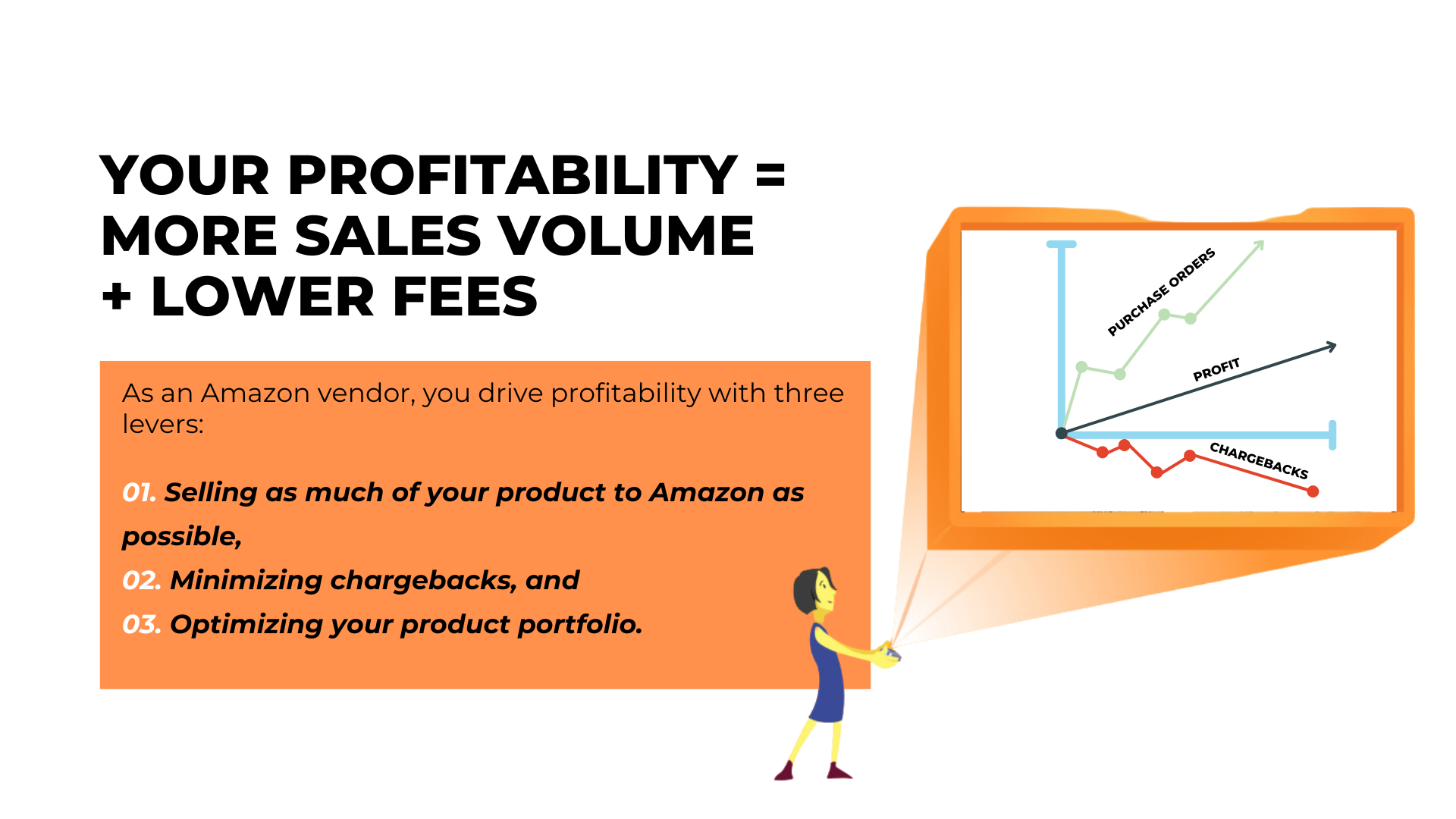Understanding Amazon Vendor Central Chargebacks: Your Guide to Uncovering Hidden Costs
In the ever-evolving world of Amazon sales, succeeding as a 1P vendor goes beyond creating and shipping top-notch products. There's a lesser-known factor that holds significant sway over your profitability: Amazon Vendor Chargebacks. These fees can quickly escalate into substantial costs, taking a toll on your bottom line. Ignoring this issue could eat away at a sizable portion of your hard-earned revenues.
This article breaks down what chargebacks really mean, explores common pitfalls that trigger them, highlights their hidden costs, and provides a practical step-by-step guide to avoid them. Additionally, we reveal the power of harnessing chargeback data to predict future demand, enabling you to make informed decisions and bolster your profitability.
Decoding Amazon Vendor Chargebacks
In the complex realm of Amazon sales, understanding the language of chargebacks is essential to navigating the intricacies of vendor compliance. Let’s unravel the key terms you need to know:
Amazon Vendor Chargeback: Consider it a fine imposed by Amazon on vendors for failing to meet their operational and logistical guidelines. These chargebacks are deducted from a vendor's payment, acting as a stern reminder to uphold Amazon's standards.
Amazon Chargeback Fee: This fee represents the specific amount subtracted from a vendor's payment for each instance of non-compliance. The fee may vary depending on the nature and severity of the violation.
Vendor Central Chargebacks: Exclusive to vendors selling directly to Amazon (1P vendors) through Vendor Central, these chargebacks are the penalties imposed for non-compliance. You can review the details of these chargebacks on the 'Chargeback Details' page within Vendor Central.
Compliance Chargeback: A specific type of chargeback related to failing to meet Amazon’s compliance requirements, such as proper labeling or packaging standards.
Common Reasons for Chargebacks
Chargeback fees have the potential to drain your profits if not handled effectively. Understanding the common reasons behind these chargebacks is key to protecting your bottom line:
Not Confirming POs: Timely confirmation of POs is critical. Amazon expects vendors to confirm their purchase orders within a specified timeframe. Failing to do so can result in chargebacks. For instance, Brand X overlooked confirming a significant PO, leading to an unexpected chargeback that eliminated their sales margin.
Late Shipment: Amazon's reputation for quick delivery relies on vendors adhering to strict shipping windows. Delayed shipments disrupt Amazon's logistics chain and can trigger chargebacks. Brand Y faced recurring chargebacks due to persistent delays caused by logistical issues with their third-party courier.
Incorrect Labeling: Accurate product labeling is vital for seamless handling and tracking within Amazon's system. Inaccurate labels can lead to misrouted items and dissatisfied customers, resulting in chargebacks. Brand Z, a toy manufacturer, experienced a series of chargebacks due to a batch of products with incorrect barcodes.
Packaging Issues: Amazon mandates specific packaging requirements tailored for efficient e-commerce operations. Inadequate packaging can lead to transit damage, negative customer experiences, and subsequent chargebacks. Brand W, after encountering a surge in chargebacks caused by products getting damaged during transit, implemented improved packaging solutions, significantly reducing chargebacks.
The Hidden Costs of Chargebacks
Chargebacks may seem like mere operational inconveniences, but they carry a weighty price tag that goes beyond a simple financial penalty. Each chargeback incurred represents a lost opportunity for sales and customer satisfaction, and its repercussions can reverberate throughout your business.
Consider Brand A, a health and beauty brand that experienced a series of chargebacks due to recurring packaging defects. While the financial penalties were burdensome, the true cost extended far beyond the monetary aspect. The disruptions caused by these chargebacks rippled through their supply chain, leading to lost sales and negative customer reviews that tarnished their reputation on Amazon. However, Brand A took a proactive approach by investing in improved packaging solutions, which helped them reduce chargebacks significantly and restore their brand reputation.
A Step-by-Step Guide to Avoid Amazon Vendor Chargebacks
To safeguard your business from the detrimental impacts of chargebacks, it's crucial to take proactive measures. Consider the following steps as part of your chargeback prevention strategy:
Confirm Purchase Orders Quickly: When a purchase order (PO) lands in your inbox, make it a priority to promptly confirm it. A dedicated team can handle PO confirmations, or you can leverage automated systems that streamline the process. By ensuring timely confirmation, you lay the foundation for a smooth transaction with Amazon.
Ensure On-Time Shipment: Partner with reliable couriers and build a buffer for unexpected delays to ensure your shipments consistently meet Amazon's stringent delivery timelines. By staying proactive and maintaining a reliable shipping process, you can avoid chargebacks triggered by late shipments and keep your operations running smoothly.
Correctly Label Items: Invest in robust quality control processes to guarantee that every product is accurately labeled. This meticulous attention to detail prevents any mix-ups or misroutes in Amazon's complex supply chain. Accurate labeling enhances operational efficiency, reduces the risk of chargebacks, and upholds your reputation for delivering the right products to customers.
Package Items Appropriately for E-commerce: Follow Amazon's packaging guidelines diligently to ensure your products are well-prepared for the journey ahead. By packaging items with care and adhering to Amazon's standards, you minimize the chances of damage during transportation and enhance customer satisfaction. This proactive approach safeguards against chargebacks resulting from inadequate packaging.
Maintain Sufficient Inventory: Although not directly linked to chargebacks, maintaining adequate inventory levels is a key factor in preventing potential issues. Having enough stock on hand allows you to confidently confirm and fulfill all incoming POs. By avoiding stockouts or fulfillment gaps, you significantly reduce the risk of chargebacks arising from unfulfilled orders.
Turning Setbacks into Comebacks: Proactive Chargeback Management
Managing Amazon vendor chargebacks requires a proactive approach to safeguard your business's profitability. From understanding the reasons behind chargebacks to mitigating their financial impact, efficient chargeback management is crucial in the competitive Amazon marketplace.
To tackle this challenge head-on, it's essential to monitor, analyze, and forecast chargeback trends based on past experiences. By harnessing the power of data, you can transform setbacks into opportunities for improvement and growth. Learn from each chargeback, identify patterns, and implement strategies to prevent future occurrences.
For vendors seeking to simplify and streamline this process, consider adopting an intelligent solution such as Reason Automation. With automation at your side, you can automate data extraction and take proactive steps to enhance your operations.
Don't let chargebacks drain your business. Take control, embrace a data-driven approach, and turn these challenges into stepping stones toward success. It's time to elevate your chargeback management strategy and propel your business to new heights on the Amazon platform.
READ MORE:
Improve Profitability
Using Product-Level Operations Data from Vendor Central
As an Amazon vendor, you drive profitability with three levers: 1) selling as much of your product to Amazon as possible, 2) minimizing chargebacks, and 3) optimizing your product portfolio.
This guide will provide frameworks to improve your Amazon business's profitability and help you leverage Vendor Central's Operations tables for deeper insight.


